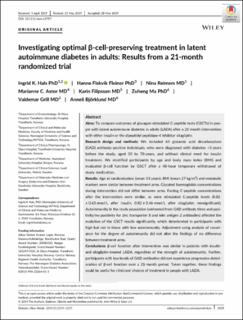| dc.contributor.author | Hals, Ingrid Kathrin | |
| dc.contributor.author | Fleiner, Hanne Fiskvik | |
| dc.contributor.author | Reimers, Nina | |
| dc.contributor.author | Astor, Marianne | |
| dc.contributor.author | Filipsson, Karin | |
| dc.contributor.author | Ma, Zuheng | |
| dc.contributor.author | Grill, Valdemar Erik Robert | |
| dc.contributor.author | Björklund, Anneli | |
| dc.date.accessioned | 2020-04-27T10:52:54Z | |
| dc.date.available | 2020-04-27T10:52:54Z | |
| dc.date.created | 2019-09-15T11:55:17Z | |
| dc.date.issued | 2019 | |
| dc.identifier.citation | Diabetes, obesity and metabolism. 2019, 21 (10), 2219-2227. | en_US |
| dc.identifier.issn | 1462-8902 | |
| dc.identifier.uri | https://hdl.handle.net/11250/2652611 | |
| dc.description.abstract | Aims
To compare outcomes of glucagon‐stimulated C‐peptide tests (GSCTs) in people with latent autoimmune diabetes in adults (LADA) after a 21‐month intervention with either insulin or the dipeptidyl peptidase‐4 inhibitor sitagliptin.
Research design and methods
We included 64 glutamic acid decarboxylase (GAD) antibody‐positive individuals, who were diagnosed with diabetes <3 years before the study, aged 30 to 70 years, and without clinical need for insulin treatment. We stratified participants by age and body mass index (BMI) and evaluated β‐cell function by GSCT after a 48‐hour temporary withdrawal of study medication.
Results
Age at randomization (mean 53 years), BMI (mean 27 kg/m2) and metabolic markers were similar between treatment arms. Glycated haemoglobin concentrations during intervention did not differ between arms. Fasting C‐peptide concentrations after the intervention were similar, as were stimulated C‐peptide levels (0.82 ± 0.63 nmol/L after insulin, 0.82 ± 0.46 nmol/L after sitagliptin; nonsignificant). Autoimmunity in the study population (estimated from GAD antibody titres and positivity/no positivity for zinc transporter 8 and islet antigen 2 antibodies) affected the evolution of the GSCT results significantly, which deteriorated in participants with high but not in those with low autoimmunity. Adjustment using analysis of covariance for the degree of autoimmunity did not alter the findings of no difference between treatment arms.
Conclusions
β‐cell function after intervention was similar in patients with insulin‐ and sitagliptin‐treated LADA, regardless of the strength of autoimmunity. Further, participants with low levels of GAD antibodies did not experience progressive deterioration of β‐cell function over a 21‐month period. Taken together, these findings could be useful for clinicians' choices of treatment in people with LADA. | en_US |
| dc.language.iso | eng | en_US |
| dc.publisher | Wiley | en_US |
| dc.rights | Navngivelse-Ikkekommersiell 4.0 Internasjonal | * |
| dc.rights.uri | http://creativecommons.org/licenses/by-nc/4.0/deed.no | * |
| dc.title | Investigating optimal β-cell-preserving treatment in latent autoimmune diabetes in adults: Results from a 21-month randomized trial | en_US |
| dc.type | Peer reviewed | en_US |
| dc.type | Journal article | en_US |
| dc.description.version | publishedVersion | en_US |
| dc.source.pagenumber | 2219-2227 | en_US |
| dc.source.volume | 21 | en_US |
| dc.source.journal | Diabetes, obesity and metabolism | en_US |
| dc.source.issue | 10 | en_US |
| dc.identifier.doi | 10.1111/dom.13797 | |
| dc.identifier.cristin | 1724777 | |
| dc.description.localcode | © 2019 The Authors. Diabetes, Obesity and Metabolism published by John Wiley & Sons Ltd. This is an open access article under the terms of the Creative Commons Attribution‐NonCommercial License, which permits use, distribution and reproduction in any medium, provided the original work is properly cited and is not used for commercial purposes. | en_US |
| cristin.ispublished | true | |
| cristin.fulltext | original | |
| cristin.qualitycode | 1 | |

